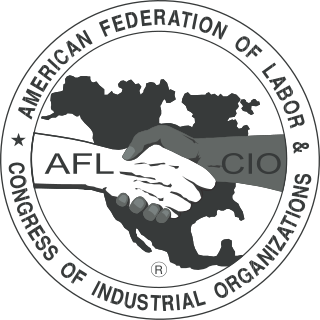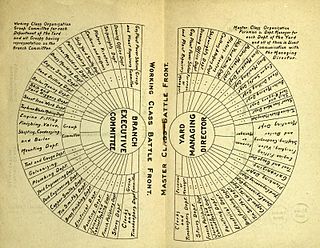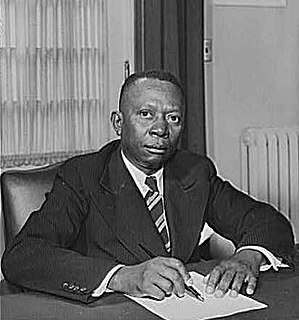Related Research Articles

The International Confederation of Free Trade Unions (ICFTU) was an international trade union. It came into being on 7 December 1949 following a split within the World Federation of Trade Unions (WFTU), and was dissolved on 31 October 2006 when it merged with the World Confederation of Labour (WCL) to form the International Trade Union Confederation (ITUC).

The American Federation of Labor and Congress of Industrial Organizations (AFL–CIO) is the largest federation of unions in the United States. It is made up of 56 national and international unions, together representing more than 12 million active and retired workers. The AFL–CIO engages in substantial political spending and activism, typically in support of liberal or progressive policies.

Industrial unionism is a trade union organizing method through which all workers in the same industry are organized into the same union, regardless of skill or trade, thus giving workers in one industry, or in all industries, more leverage in bargaining and in strike situations.

William Vacanarat Shadrach Tubman was a Liberian politician. He was the 19th president of Liberia and the longest-serving president in the country's history, serving from his election in 1944 until his death in 1971.

Montserrado County is a county in the northwestern portion of the West African nation of Liberia containing its national capital, Monrovia. One of 15 counties that comprise the first-level of administrative division in the nation, it has 17 sub political districts. As of the 2008 Census, it had a population of 1,118,241, making it the most populous county in Liberia. The area of the county measures 1,912.7 square kilometres (738.5 sq mi), the smallest in the country. Bensonville serves as the capital.

UNITE HERE is a labor union in the United States and Canada with roughly 300,000 active members. The union's members work predominantly in the hotel, food service, laundry, warehouse, and casino gaming industries. The union was formed in 2004 by the merger of Union of Needletrades, Industrial, and Textile Employees (UNITE) and Hotel Employees and Restaurant Employees Union (HERE).
The trade unions of Tanzania have a total membership of approximately 370,000. 350,000 of these belong to the Trade Union Congress of Tanzania, another 15,000 to the Zanzibar Trade Union Congress, and 2,400 are members of the Tanzania Fishing Crew and Allied Workers’ Union.
Irving Brown was an American trade unionist and leader in the American Federation of Labor (AFL) and subsequently the AFL-CIO. Brown played a prominent role in Western Europe and Africa during the Cold War in splintering communist-led labor movements. Along with former Communist Party of the USA member Jay Lovestone, he founded the American Institute for Free Labor Development in 1962.

The ICFTU Inter American Regional Organisation of Workers was the regional organization of the International Confederation of Free Trade Unions (ICFTU) for the Americas.
The Martin Luther King. Jr. County Labor Council, AFL–CIO, (MLKCLC) is the central body of labor organizations in King County, Washington. The MLKCLC is affiliated with the national AFL–CIO, the central labor organization in the United States, which represents more than 13 million working people. Over 125 organizations are affiliated with the MLKCLC, and more than 75,000 working men and women belong to Council-affiliated organizations. Not only does the MLKCLC support labor organizations, but it acts as a voice for the interests and needs of the working people in King County, WA.

The Ghana Trades Union Congress is a national centre that unites various workers' organizations in Ghana. The organization was established in 1945.
Railway Labor Executives' Association (RLEA) was a federation of rail transport labor unions in the United States and Canada. It was founded in 1926 with the purpose of acting as a legislative lobbying and policy advisory body. At times, it played a prominent role in setting rail transport policy in the U.S., and was party to six U.S. Supreme Court cases. It disbanded in January 1997, with representation, collective bargaining, and legislative lobbying assumed by the newly formed Rail Division of the AFL–CIO Transportation Trades Department.
Liga Geral dos Trabalhadores de Angola was an Angolan trade union organization in exile. Being based amongst Angolan refugees in neighbouring Congo-Kinshasa, LGTA was linked to the National Liberation Front of Angola (FNLA). During the 1960s, LGTA was the largest Angolan trade union outfit.
The Somali Confederation of Labour was a national trade union centre in Somalia. CSL was founded in 1949. CSL was closely linked to the ruling Somali Youth League, but retained organizational independence.

The Congress of Industrial Organizations (CIO) was a federation of unions that organized workers in industrial unions in the United States and Canada from 1935 to 1955. Originally created in 1935 as a committee within the American Federation of Labor (AFL) by John L. Lewis, a leader of the United Mine Workers (UMW), and called the Committee for Industrial Organization. Its name was changed in 1938 when it broke away from the AFL. It focused on organizing unskilled workers, who had been ignored by most of the AFL unions.
The United Workers Congress of Liberia was a trade union centre in Liberia.
The Liberian Federation of Trade Unions was a trade union centre in Liberia.
Amos N. Gray was a Liberian trade unionist. Born in Pull River, Maryland County, Gray attended primary school in Pull River and secondary school in Harper. He attended college in Monrovia, studying social studies for two years and law for one year. During his college years he worked part-time at the Freeport of Monrovia. Working at the port in 1960, he joined the Maritime and Dock Workers Union. After his college years he worked at the Maritime and Dock Workers Union office in Monrovia.
Jacobus Hendrik Oldenbroek was a Dutch trade union leader and politician, who served as general secretary of the International Confederation of Free Trade Unions.
References
- 1 2 Siegfried Mielke (27 November 2013). Internationales Gewerkschaftshandbuch. Springer-Verlag. p. 738. ISBN 978-3-322-95471-8.
- 1 2 3 World Trade Information Service. U.S. Government Printing Office. 1956. p. xlviii.
- 1 2 3 Akhmed Akhmedovich Iskenderov (1964). The Workers Movement of the Countries of Asia and Africa. CCM Information Corporation. p. 120.
- 1 2 Jean Meynaud; Anisse Salah-Bey (1967). Trade unionism in Africa: a study of its growth and orientation . Methuen. p. 171.
- 1 2 Yearbook of the inte. 1962. p. 507.
- 1 2 3 Liberia-forum. Liberia Working Group. 1988. p. 35.
- ↑ Labor in Liberia. U.S. Department of Labor, Bureau of Labor Statistics. 1960. p. 16.
- 1 2 P. Schechter (2 January 2012). Exploring the Decolonial Imaginary: Four Transnational Lives. Springer. pp. 159–160. ISBN 978-1-137-01284-5.
- 1 2 Martin Lowenkopf (1976). Politics in Liberia: the conservative road to development. Hoover Institution Press. p. 100. ISBN 978-0-8179-6511-2.
- 1 2 Labor Digests on Countries in Africa. U.S. Government Printing Office. 1966. p. 4.
- 1 2 3 United States. Bureau of International Labor Affairs; United States. Bureau of Labor Statistics (1966). Directory of labor organizations: Africa. For sale by the Superintendent of Documents, U.S. Govt. Print. Off. pp. 19–5.
- ↑ Nancy V. Rawls (1966). Establishing a Business in Liberia. Department of Commerce, Bureau of International Commerce. p. 9.
- 1 2 A. P. Coldrick; Philip Jones (1979). The international directory of the trade union movement. Macmillan. p. 297.
- ↑ Martin Upham (1991). Trade Unions of the World. Longman Group UK Limited. p. 286.